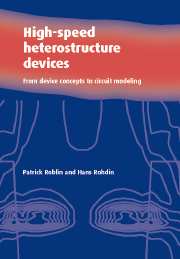Book contents
- Frontmatter
- Contents
- Preface
- Acknowledgements
- List of abbreviations
- Introduction
- 1 Heterostructure materials
- 2 Semiclassical theory of heterostructures
- 3 Quantum theory of heterostructures
- 4 Quantum heterostructure devices
- 5 Scattering processes in heterostructures
- 6 Scattering-assisted tunneling
- 7 Frequency response of quantum devices from DC to infrared
- 8 Charge control of the two-dimensional electron gas
- 9 High electric field transport
- 10 I – V model of the MODFET
- 11 Small- and large-signal AC models for the long-channel MODFET
- 12 Small- and large-signal AC models for the short-channel MODFET
- 13 DC and microwave electrothermal modeling of FETs
- 14 Analytical DC analysis of short-gate MODFETs
- 15 Small-signal AC analysis of the short-gate velocity-saturated MODFET
- 16 Gate resistance and the Schottky-barrier interface
- 17 MODFET high-frequency performance
- 18 Modeling high-performance HBTs
- 19 Practical high-frequency HBTs
- Index
18 - Modeling high-performance HBTs
Published online by Cambridge University Press: 06 July 2010
- Frontmatter
- Contents
- Preface
- Acknowledgements
- List of abbreviations
- Introduction
- 1 Heterostructure materials
- 2 Semiclassical theory of heterostructures
- 3 Quantum theory of heterostructures
- 4 Quantum heterostructure devices
- 5 Scattering processes in heterostructures
- 6 Scattering-assisted tunneling
- 7 Frequency response of quantum devices from DC to infrared
- 8 Charge control of the two-dimensional electron gas
- 9 High electric field transport
- 10 I – V model of the MODFET
- 11 Small- and large-signal AC models for the long-channel MODFET
- 12 Small- and large-signal AC models for the short-channel MODFET
- 13 DC and microwave electrothermal modeling of FETs
- 14 Analytical DC analysis of short-gate MODFETs
- 15 Small-signal AC analysis of the short-gate velocity-saturated MODFET
- 16 Gate resistance and the Schottky-barrier interface
- 17 MODFET high-frequency performance
- 18 Modeling high-performance HBTs
- 19 Practical high-frequency HBTs
- Index
Summary
And we must take the current when it serves, or lose our ventures
King Lear, Act 4, Scene 3, William ShakespeareIntroduction
Epitaxial-layer, bipolar transistors are intrinsically well suited to high-frequency applications because their critical, physical dimensions are mainly in the direction of the semiconductor film growth, which can be controlled on a near-atomic scale. This is in contrast to field-effect transistors (FETs), where the critical dimension of gate length must be determined lithographically.
Among the family of bipolar transistors, heterojunction bipolar transistors (HBTs) are particularly attractive for operation at high frequencies because their employment of a wide-bandgap emitter allows a highly doped base region to be used without compromising the current gain [1]. With a highly doped base, the base width can be reduced while still maintaining an acceptable base resistance. A short base width leads directly to an improved cut-off frequency, fT, which, when coupled with the lower base resistance, leads to an improved oscillation frequency, fmax. These, and other, attributes of HBTs have been reviewed [2].
In this chapter, some important aspects of modeling high-performance HBTs are discussed. The aims are twofold: (i) to gain some insight into the workings of an HBT at the microscopic level; (ii) to use this insight to examine, or develop, analytical expressions which may be useful in the engineering design of high-frequency and high-speed devices.
At the microscopic level, the emphasis is on the collector current density, JC.
Information
- Type
- Chapter
- Information
- High-Speed Heterostructure DevicesFrom Device Concepts to Circuit Modeling, pp. 613 - 650Publisher: Cambridge University PressPrint publication year: 2002
Accessibility standard: Unknown
Why this information is here
This section outlines the accessibility features of this content - including support for screen readers, full keyboard navigation and high-contrast display options. This may not be relevant for you.Accessibility Information
- 2
- Cited by
